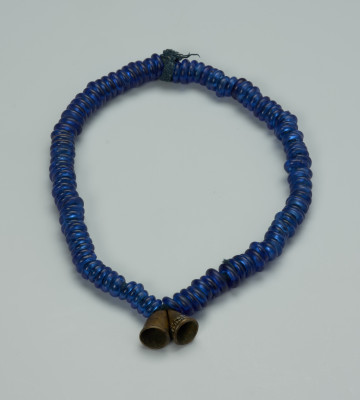
Necklace
między 1920 — 1930
National Museum in Szczecin
Part of the collection: Collection of Dogonian art
The open bracelet was made by a Dogon smith - irine, who also makes ornaments from copper, bronze, brass, and aluminium in addition to woodworking and ironworking. It is an old-type quite heavy bracelet. In the past, it was worn on the wrist by Dogon women. Most probably, it was cast from copper rods, which were then forged on an anvil. Traces of forging are clearly visible on the inside of the bracelet. The traditional costume of a Dogon woman consists of a rectangular cotton skirt called numonay wrapped around the hips and tied with a belt. Skirts can be indigo, white-blue or coloured. Nowadays, they are increasingly replaced by factory fabrics. With the introduction of the regulation that women must cover their breasts when going outside the village, e.g., to the market, loose-fitting blouses became a novelty in women's costumes. Jewellery is a particularly significant addition to a woman's outfit. The essential ornaments are necklaces with pendants and bracelets worn mainly on the wrists. In the past - until the mid 20th century - women mainly wore large and heavy bracelets made of copper or iron. Nowadays, light and delicate products predominate. Also, the hairstyle is important for women, as it is decorated with many metal rings or beads made of agate, glass, quartz or even marble. A significant but now disappearing way of decorating men and women's bodies is scarification, which is performed before initiation. It usually takes the form of vertical incisions on the temples. The number of incisions is not without significance. For women, four vertical incisions are used, as the number 4 is a female symbol, and each incision is supposed to represent a vulva. For men, three incisions are made, and the knife cutting the skin symbolises the male member. By the end of the 20th century, scarification was already rare and can still be seen on the bodies of older women.
Katarzyna Findlik-Gawron
Author / creator
Dimensions
cały obiekt: height: 2,4 cm, width: 9,3 cm
Object type
body adornment, jewellery
Creation time / dating
Creation / finding place
Identification number
Location / status

między 1920 — 1930
National Museum in Szczecin

między 1920 — 1930
National Museum in Szczecin

około 1930
National Museum in Szczecin
DISCOVER this TOPIC
Museum of King Jan III's Palace at Wilanów
DISCOVER this PATH
Educational path